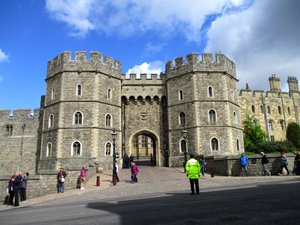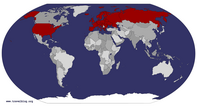Advertisement
Published: April 27th 2018

 Windsor Castle
Windsor Castle
The Henry VIII gateway in the Lower Ward.All hands were on deck early this morning, as we had booked an all-day excursion to visit some sights outside of London: Windsor Castle, Stonehenge and Oxford. It turned out to be a grueling, 14-hour marathon, although a good deal of the time was spent sitting in the seats of a coach bus with about 40 other tourists.
Over the past several years, Dee and I have taken our fair share of tours (in Tuscany, Provence and Sicily, for example), so we're familiar with the rigid timetables and "cattle drive" feeling associated with them. But today's itinerary, as it turned out, was too crammed and hurried for our taste.
The bus departed from the tour company's office, near Victoria Station, at 8:30AM. By 9:30 we reached Windsor Castle, about 25 miles west of London, in the English county of Berkshire. As most of you know, Windsor Castle is the preferred weekend retreat of the reigning monarch, Queen Elizabeth II, whose standard flies from the Round Tower when she is in residence.
The castle occupies 13 acres, and combines the features of a fortification, a palace, and a small town. In essence, the castle is of Georgian and Victorian
design, based on a medieval structure, with Gothic features reinvented in a modern style.
William the Conqueror chose the site for Windsor Castle, high above the river Thames, on the edge of a Saxon hunting ground. He began building at Windsor around 1070, and 16 years later the castle was complete. It was originally constructed to guard the western approach to London. Since the time of Henry I, it has been used by the reigning monarch and is the longest-occupied palace in Europe.
From the 1350s up until his death in 1377, Edward III turned Windsor from a military fortification to a Gothic palace, spending more than any other medieval English king spent on any other single building, and it has been the home of British kings and queens for almost 1,000 years.
Windsor Castle is still very much a working royal palace and is regularly used for ceremonial and State occasions, including official visits from overseas Heads of State. St George’s Hall makes a spectacular setting for a State Banquet, when a table seating 160 guests is decorated with porcelain and silver from the Royal Collection.
The tour schedule called for about 2 hours to

 Guard detail
Guard detail
Changing of the Guard ceremony at Windsor Castle.visit the castle, but 45 minutes of our time was consumed by a long queue of people passing through security screening, which was almost airport-like in nature. When we finally entered the castle grounds, Dee and I decided to forgo the State Apartments, and instead focused on St. George's Chapel. Larry and Danielle, who made a mad dash through the apartments, had to hustle to return to the bus in time.
This chapel was established in the 14th-century by King Edward III, and was extensively enlarged in the late 15th-century. It has been the venue for many royal ceremonies, weddings and burials. Located in the Lower Ward section of the castle's grounds, it's the planned burial site for Queen Elizabeth, and the wedding between Prince Harry and Meghan Markle will be celebrated here next month.
As we were leaving the castle's grounds, during a brief rain shower, Dee headed for a nearby pub for some take-out sandwiches to eat on the bus, while I managed to capture part of the changing of the guard ceremony. We barely made it back to the bus at the appointed time, eating our lunch during the 90-minute drive to Stonehenge.
One
of the most famous landmarks in the UK, Stonehenge is regarded as a British cultural icon. Stonehenge is a prehistoric monument located on the Salisbury Plain, in the county of Wiltshire, about 88 miles southwest of London. It consists of a ring of standing stones, with each standing stone around 13 feet high, 7 feet wide and weighing around 25 tons.
The stones are set within earthworks in the middle of the most dense complex of Neolithic and Bronze Age monuments in England, including several hundred burial mounds. Stonehenge could have been a burial ground from its earliest beginnings.
Archaeologists believe it was constructed from 3000 BC to 2000 BC. The surrounding circular earth bank and ditch, which constitute the earliest phase of the monument, have been dated to about 3100 BC. Radiocarbon dating suggests that the first bluestones were raised between 2400 and 2200 BC.
Several theories have been advanced over the years as to the purpose and function of the Stonehenge works, including usage as an astronomical observatory, or as a religious site. More recently, as our tour guide pointed out, it has been suggested that Stonehenge was considered a place of healing, arguing that
this may account for the high number of burials in the area, as well as the high incidence of deformities identified in the excavated remains.
The area in which Stonehenge rests is bucolic, with lush fields of green as far as the eye can see. Much like the initial reaction of many people to Leonardo da Vinci's
Mona Lisa, which hangs in the Louvre, Stonehenge is smaller than I'd envisioned. Nevertheless, it does present a striking image, even from a distance.
Our last destination of the day was Oxford (pop. 170,000+), a city in the the county of Oxfordshire, situated 57 miles to the west of London. Oxford is often referred to as the "city of dreaming spires”, a term coined by the poet Matthew Arnold. Many of the buildings we would see during our walking tour today represent examples from every English architectural period since the late Saxon period.
Although the precise founding date of the University of Oxford is unknown, there is evidence of teaching as far back as 1096, which makes it the oldest university in the English-speaking world. As our guide explained, the university grew rapidly after 1167 when Henry II banned English
students from attending the University of Paris.
The university actually consists of 38 separate colleges, each of which operates as a self-governing institution within the university. Our guide led us on a 30-minute walk past such familiar colleges as Christ Church, Merton, Oriel, Balliol and All Souls, to name just a few.
Two of the most impressive sights we passed were the Radcliffe Camera ("Camera", meaning "room" in Latin), a neo-classical style structure built between 1737–49 to house a science library; and the Bodleian Library, which is one of the oldest libraries in Europe.
The Bodleian's massive tower forms the main entrance to the library, and is known as the "Tower of the Five Orders", so named because it is decorated, in ascending order, with the columns of each of the five orders of classical architecture: Tuscan, Doric, Ionic, Corinthian and Composite.
While walking to the point where the bus would pick us up, Danielle located the symbol of the cross in the roadway that commemorates the so-called Oxford Martyrs. The three martyrs, the bishops Hugh Latimer and Nicholas Ridley, and the archbishop Thomas Cranmer, were tried for heresy in 1555 and subsequently burnt at the

 Martyrs' Cross
Martyrs' Cross
City of Oxfordstake, on what is now Broad Street, for their religious beliefs and teachings.
Our tour over, we arrived back at the Victoria Station in London at 7PM, where we caught a taxi that quickly became mired in traffic, so much so that the driver executed a U-turn and took an alternative route. Forty-five minutes later, and £40 ($60) lighter in our pocketbooks, we made it back to our flat. I think all of us were thankful that today's ordeal was finally over!
Dee's comments: Up at the butt-crack of dawn again today to catch a cab; more traffic gridlock; a full bus load on the tour this time, about half English-speaking, the rest Spanish-speaking (with their own tour guide).
First stop at Windsor Castle, where we visited the lovely chapel where the wedding of Harry and Meghan Markle will take place soon (I'm sure our invitation is in the mail, LOL!). Lots of people visiting the castle today; stopped to buy take-out lunches at a great little pastry and sandwich shop outside the castle.
Then off to Stonehenge, where massive stone ruins are plopped in the middle of beautiful, green pastures; the sun was shining most
of the time, but it was cool and blustery while we were there.
Next stop Oxford, where there's been a whole lot of education going on for centuries; much history about this university (have to do a lot of reading about it when I get home).
On our way back to the bus, Danielle stopped in her tracks when she smelled bacon frying. It turned out to be a cute little place making all kinds of bacon sandwiches served on mini-baguettes. Mitch had a BLT, while Danielle, Larry and I ordered bacon with brie and, of course, hot peppers for me. What a treat to eat during the long bus ride back to London!
Danielle and Larry are getting ready to return to the USA, leaving the flat via taxi early Sunday morning. Stay tuned for our last few days in London, where the weather has suddenly turned rainy and chilly.
Advertisement
Tot: 0.088s; Tpl: 0.013s; cc: 8; qc: 23; dbt: 0.0514s; 1; m:domysql w:travelblog (10.17.0.13); sld: 1;
; mem: 1.2mb























Jeni
non-member comment
Windsor Castle is far more impressive than I could have imagined, the grand reception room is just that GRAND! This was a lot in one day. Stonehenge is amazing but I always think of the movie Spinal Tap when I see it! ? if you don’t know what I’m talking about you need to look it up. Happy you made it back to the flat in one piece, take day to rest and eat some good pub grub.